
The Berlin Airlift is one of my favorite historical projects, and this is the third of four posts on the topic.
Introduction
Tunner quickly went about introducing order and structure to what he called a “cowboy operation”.
There would be a rigid schedule for flights, pilots would be assigned to aircraft with a specific take-off and arrival times. The aircraft would fly at five altitudes. Aircraft at one altitude would be separated by 15 minutes. Aircraft would take-off and land at 3-minute intervals. Radio beacons along the route allowed the crews to maintain the correct separations.
There would be no deviation and no room for initiative. This was deadly serious, and lives were at stake.
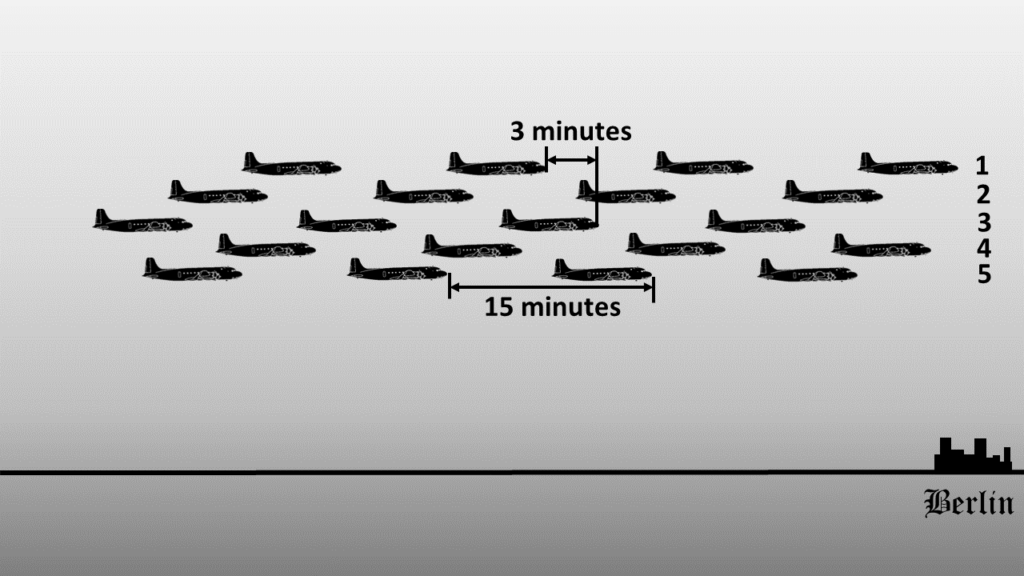
Measure Everything
Tunner was data driven and believed that a successful airlift should be routine, in fact boring, there was no room for the wild freewheeling atmosphere that prevailed before his arrival. Tunner believed that aircraft should, be flying, loading/unloading, or being maintained in preparation to fly. The same was true of pilots, they should be flying, training, or resting in preparation for flying.
He had analyzed the failed German airlift during the siege of Stalingrad and concluded that the Germans had the aircraft and resources to have succeeded; the problem was one of organization.
Tunner and his team started gathering statistics on every aspect of the airlift and displayed the data on boards at the various airlift bases.
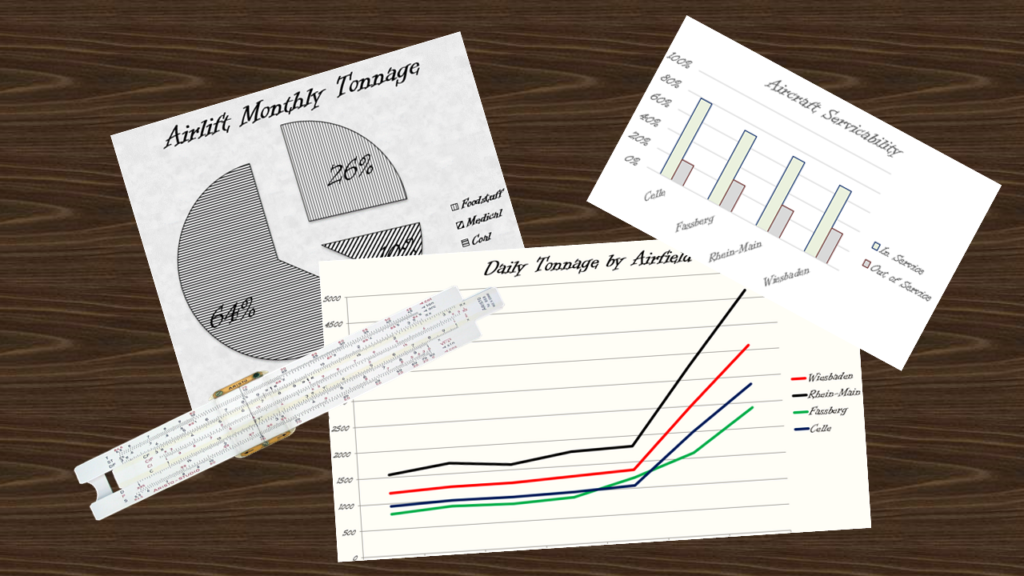
The daily tonnage started to rise but these measures could only achieve so much. More aircraft were required, as well better maintenance facilities and procedures.
There was also a lack of landing capacity in Berlin, and what was available was deteriorating rapidly under the 24/7 operation. Indeed, groups of German civilians (mostly women) were employed to rush onto the runway after each landing. With nothing more than hand tools and wheelbarrows they repaired the damage done by the landing, and just as quickly rushed off before the next plane.
The Candy Bomber
Whilst Tunner was “getting his feet under the table”, a young pilot was implementing and initiative that would have a have an enormous impact on the success of the airlift.
Gail Halvorsen had flown transport aircraft in secondary theatres during WWII.
Following the war, he renewed his enlistment and appeared set to have a competent but unremarkable career in an unfashionable branch of the air force. When the airlift started, he was serving in the U.S. The crews were briefed on the situation and several C-54 crews were assigned to the airlift. One of them was his good friend Since he was flying at the time, Halvorsen called his wife to give her the news. With a new family she was devastated. This made Halvorsen think. He was single, so he requested that he be transferred to replace his friend. This was done and he was soon on his way to Germany.
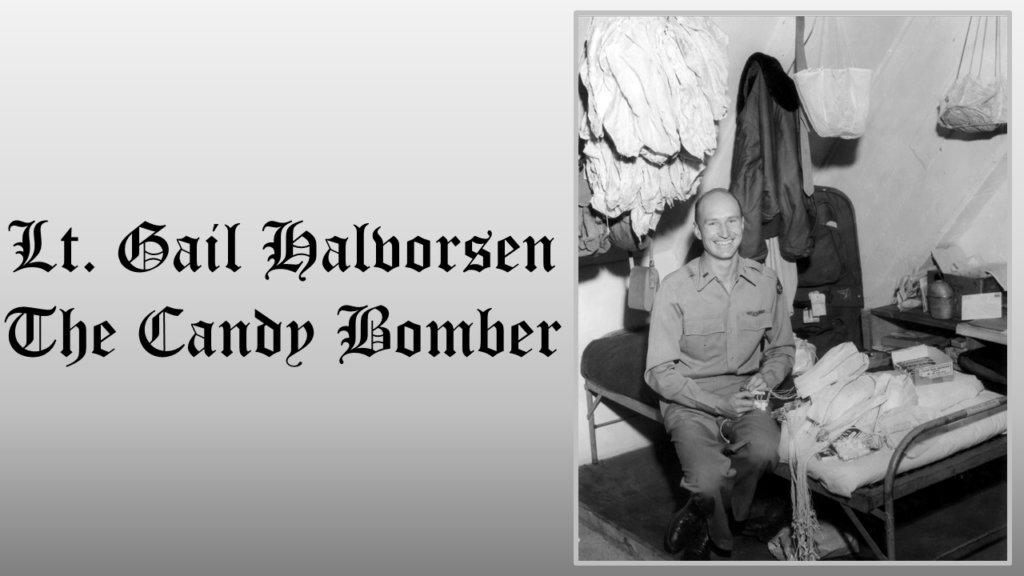
Once in Germany he began to fly regular flights to Berlin, but never had a chance to see the city. So, he hitched a flight to Berlin during his off time and had a tour of the ruined city. On return to the airport he walked around and encountered a group of children at the end of the runway watching the planes. Somehow, they were able to communicate, and Halvorsen was impressed that the did not ask for anything. Before he left, he gave them the few sticks of gum he had, and promised if they were there next day, he would drop them some candy (Totally against the standing regulations). They asked how they would know his plane, he demonstrated that he would wiggle his wings.
He persuaded his crew (who were initially less than happy) to contribute their candy allowance. Realizing that the candy would not survive the drop, he crafted and tested rudimentary parachutes from handkerchiefs.
On their next flight he started to have some reservations but as they approach the airport, he saw the group of children in the same place. As he wiggled his wings, he saw them jump and wave. As they passed over the candy packages were dropped out through the flare chute, and “The Candy Bomber” was born.
Tegel
Meanwhile the efficiencies were having an effect and the daily tonnage figures climbed. For the first time on August 12th, the tonnage figure exceeded the minimum requirement.
However, it was obvious that the efficiencies could only go so far and without more landing capacity the airlift would still fail.
On August 5th work was begun on a new airfield at Tegel in the French Sector.

One of the problems was material. However, the allied bombing had produced vast quantities of rubble and an army of German women gathered and transported the rubble which was sorted and crushed to make the base for the runways. These resilient Trummerfrauen (women of the rubble) who had survived, the allied bombing, the soviet storming of Berlin, the grizzly aftermath and the post war austerity, worked day in day out to build this new airfield mostly by hand. There were still tasks which required heavy equipment, but there was little or none in Berlin, until someone remembered a member of the Hump* team. He specialized in cutting-up heavy heavy with a torch, shipping the parts and then welding them back together at the other end. These parts were often still too large for the side loading C-54s, but not the rear loading Fairchild C-82 Packet.

The new airfield opened on November 5th, completed in just 3 months, an incredible achievement of ingenuity and grit.
Maintenance
As conditions became better for the aircrews, the did not for the maintenance crews. There was an acute shorted of trained and competent maintenance personnel, and the condition of aircraft was deteriorating. Tunner had identified many ex-Luftwaffe, maintenance personnel, but there was opposition to the idea from Airforce brass, who believed there would be wide spreads sabotage. This was a decision that only general Clay could approve, but Tunner was prohibited from speaking to him directly.
Tunner contrived to be at Tempelhof airport when he knew that Clay would be passing through. At this “chance” meeting Clay of course asked how things were going and if he needed anything. Tunner explained the situation of the German mechanics and Clay immediately approved their recruitment. As he was leaving, he apparently said with a sly grin, “tell Curtis I said it was OK”.
Recruitment started immediately, however one issue still existed, all the manuals were in English and a rapid translation project was implemented.
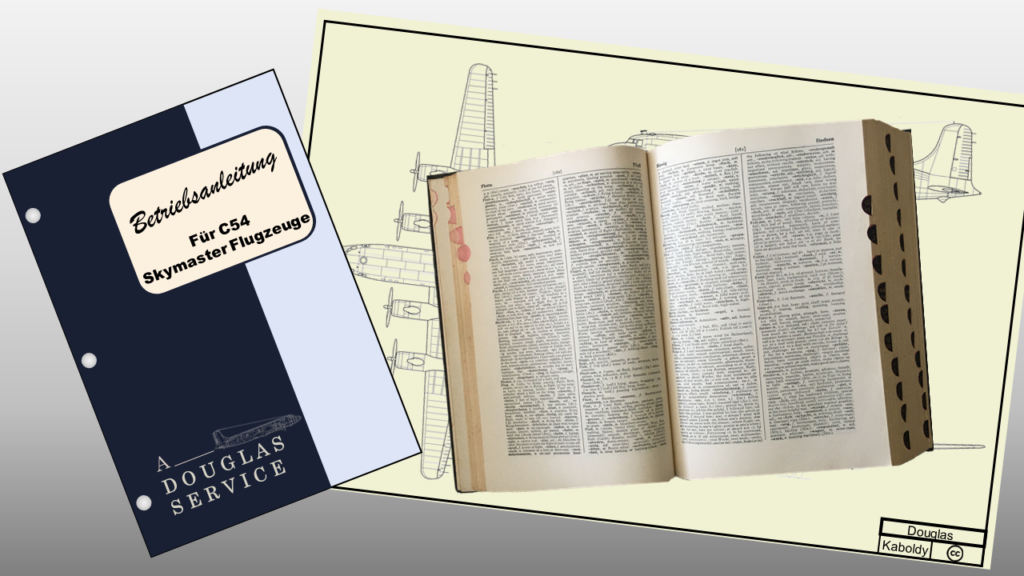
Maintenance procedures were refined and streamlined. Specific bases within Germany and England would specialize in the more complex or technical procedures, like engine changes.
As the month passed serviceability numbers rose.
Loading and Unloading
When the airlift started the loading and unloading procedures were erratic and, in some cases, inefficient. This resulted in the aircraft crews wandering off to the terminal for refreshments etc.
Everything was tightened up and the unloading/loading processes finally resembled modern day motor racing pit-stops. Mobile canteen facilities were available in the loading areas, so the crews could quickly re-board their planes and make the return journey.
Everything was done to realize Turner’s vision of efficiency.
Cargo
We have looked at several efficiencies and innovative ideas to improve the daily tonnage figures, but a great deal of effort went into determining what should be shipped.
British government departments after years of war and shortage, had a clear understanding of what was required for a healthy and balanced diet. This knowledge was used to determine what would give the best nutritional value for the lowest tonnage. With that in mind powdered potatoes were shipped, rather than the real thing.
It was also determined whether to ship a finished produce or the component parts. For example, bread contains a high proportion of water, so it was more efficient to ship flour and coal and bake the bread in Berlin.
In addition, a great deal of effort went into balancing loads, so that as far as possible each plane flew as close to its maximum payload as possible.
In the age before computers all this was done with slide rules.
The People
Ultimately projects come down to people, you can employ technologies and systems, but ultimately it is about what people do or are willing to do.
The Candy Bomber
With that in mind let us return to Gail Halvorsen.
His candy drops missions eventually drew attention, in the form of letters and cards from appreciative German children and parents, until one day a journalist witnessed a candy drop and noted Halvorsen’s tail number. On landing he was ordered to report to his CO who informed him that General Tunner wanted to see him. With some trepidation he reported to Tunner. He was asked if he was dropping candy, to which he replied yes, fully expecting to be disciplined. But Tunner recognized the publicity value of this and instructed Halvorsen to continue and expand the operation. They were even given permission to deviate from the rigid flight pattern.
So, a much-relieved Halvorsen returned to his unit, to step up the candy drops.
Later he was sent on a publicity trip to the US, making various appearances, resulting in huge support from individuals, organizations, and confectionary manufactures.
Years later, old German men and women would still fondly recall the effect the candy drops had on them as children.
The Politician
During the airlift, the Soviets made every effort to alternatively intimidate and cajole the population of West Berlin away from the allies.
Eventually an independent West Berlin council was established with Ernst Reuter as Mayor. A position he had been denied in 1946, by the soviet veto.
As Clay worked to arrange more aircraft and resources he met with Reuter and asked him if the Berliners would hold out. Reuter informed him that the Berliners had no love for the Soviets and would continue to defy them even if the allies left.
On, the 9th of September 1948 Reuter addressed a massive crowd outside the ruined Reichstag building, imploring the west not to abandon Berlin, sending a clear message that Berliners would stand firm.

The Cartoonist
Tunner understood the value of communicating with the various teams, through notice boards, and the airlift newspaper the “Task Force Times”.
His radio operator Jake Schuffert was a talented cartoonist whose humorous cartoons featured in the newspaper and helped lift moral.

Tunner was a great believer in friendly rivalry to stimulate performance, as illustrated in one of Jake’s Cartoons.

The General
General Jean Ganeval was the French military commandant in Berlin, and in late 1949 he had a problem. The new airfield at Tegel was operational, but there were two large radio masts, which were a hazard to operations, that were controlled by the Soviet Radio Berlin. Despite repeated requests for a meeting and requests to relocate the masts, the Soviet commandant steadfastly ignored them. Losing patience Ganeval, informed the Soviets that if the situation were not resolved by December 16th, he would act. Nothing was heard.
On the 16th of December , French troops surrounded the masts and removed the German and Soviet staff, who were later bussed back to the Soviet sector.
French engineers blew both towers, and the hazards were removed.
Shortly afterwards General Kotikov the soviet commandant, stormed into Ganeval’s office screaming “How could you do it”.
Ganeval is said to have replied with a gallic shrug, “Très simple. Avec le dynamite!”.
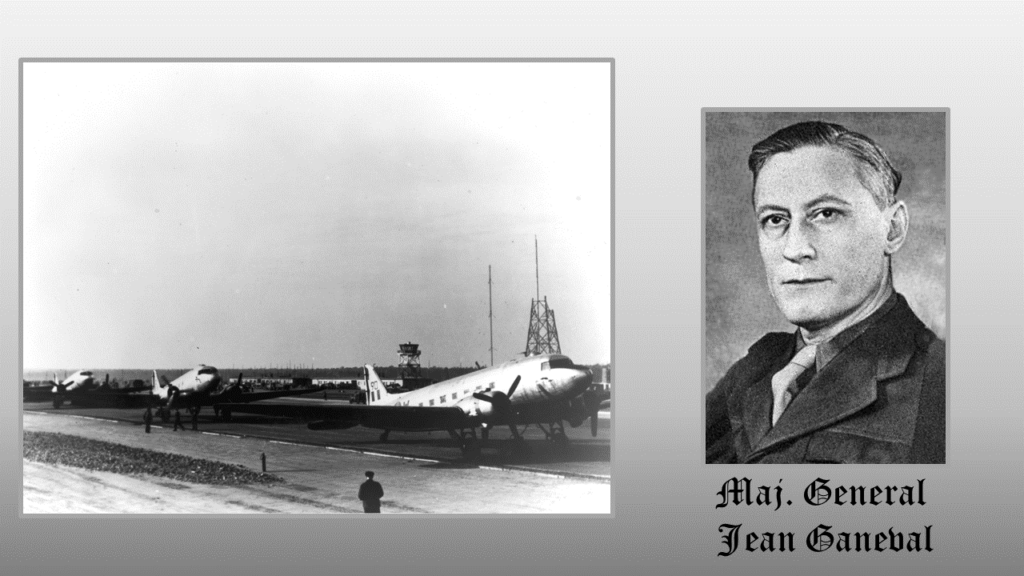
Victory
The airlift went from strength to strength despite some bleak days during the winter of 48/49. By spring 1949 the average daily tonnages were steadily climbing.
Tunner decided to have a massive 24 hr. push for Easter, named the Easter Parade. The target was 10,000 tons and 1,400 flights. The final tally was 12,941 tons and 1,398 flights. (This was more than the average daily shipment by land prior to the blockade)
It now became clear to the Soviets that they had lost.
Not only had the west demonstrated that they could supply Berlin by air, but many eastern German companies were being crippled by the west’s counter blockade. They had failed to anticipate the effects of a blockade by the west.
The Soviets lifted the blockade on the 12th of May 1949.
However, the airlift continued until the 30th of September.
The Numbers


The airlift was not just about dull statistics, there was real human tragedy and sacrifice. Eighty-three service men and civilian lost their life directly during the airlift. However, there were unknown numbers who simply disappeared during the Soviet terror that accompanied it.
Finally, in case you are wondering around 23 tons of candy were parachuted into Berlin.
Conclusion
The Berlin airlift was round one of the “cold war” and helped shape our current world by stopping what had appeared to be the irresistible western advance of communism.
The most notable outcomes were:
- Harry Truman was re-elected President in 1948. (He was expected to lose in a landslide)
- NATO was formed in 1949
- West Germany was founded as a democratic federal republic in 1949
- The Treaty of Rome was signed by 6 western European nations, including W. Germany in 1957 (This group would grow into the EU)
- The Berlin Wall was raised in 1961
- The lessons from the airlift led to the development of the modern military and civilian air transport systems.
General Clay arrived in Germany as a military governor, with ideas of applying harsh policies, he left as a hero, as did all the western service personnel.
General Tunner went back to his old job, whilst General LeMay claimed credit for the airlift success. History would correct this and Tunner is seen as the architect of the most successful airlift in history.
Gail Halvorsen went back to the US and married his sweetheart. He is the human face of the airlift, and no history is complete without his mention. He shows us how simple actions from pure intention, can move millions.
Prior to the airlift Berlin was considered the crime capital of the world and service personnel were warned not to go out alone at night, or they would have their throat cut. During and after the airlift their main concern was how they were going to drink all the beer provided for them.
What can we take from this as project managers?
- People matter – with the correct leadership and support great things can be achieved
- Communicate your vision and get buy-in
- Understand your stakeholders
- Perform proper business analysis
- Measure what matters
- Like Tunner, you may have to bend the rules
- Dare Greatly
American service personnel gave much to help ensure freedom and liberty for the peoples of Western Europe. But one group of service personnel in the segregated military did not enjoy the same freedom and liberty when they returned to the United States. We will look at their history in the concluding post of the series.

Each article better than the previous one!
Keep doing what you’re doing Jim!